An interview with small Steps’ Paul Pickle
What does sustainability mean to Small Steps?
Not only are we practicing sustainability for the environment, but we see it as an investment into our community's future. The primary idea behind sustainability was actually not environmental; it centered around the idea of building a home that could survive the test of an economic downturn. The goal is that when donors fall on hard times and donations temporarily stop flowing, the program, center and positive impact to the community would not die. I've seen first hand, the effects of the 2008 global economic crisis and what it did to children's centers that were living on donations month to month. We want to teach a man to fish so that he can eat for the rest of his life. That goes not only for our home at Small Steps, but for the entire surrounding community.
How have you made the facility at Small Steps more Sustainable?
Sustainability is really about minimizing waste or maximizing reuse. We plant rotational crops that will keep the soil fertile. We raise fish for the girls to eat. Fish eat food, and then excrete waste heavy in ammonia. Nitrifying bacteria then converts the ammonia to nitrites and then to nitrates with the solids converted to vermicompost that then becomes plant food for the banana trees, coffee plants, and other food sources on our land. It would be "more convenient" to simply buy a bag of fertilizer, but then we would be wasting fertilizer already being made on property.
Sustainability for the community means that we produce products from the land, consume a portion and sell the other portion to the community at a discount, or barter for goods and services. Nothing goes unused and everything comes full circle.
“Nothing goes unused and everything comes full circle”
How have you made the facility at Small steps more self sufficient?
We've started this project with the idea that we would raise the capital expense spend necessary to allow for low operating expense. For example, electricity was running us as much as $800/month to support 4 girls and 2 house moms. Solar power was quoted at $35k. While $35k is a lot higher than $800/month, the return on investment was 3.6 years! Which is pretty good (anything less than 5 is good). But if you think in terms of sustainable operation, if monthly donations dry up due to some disruption of supply, the $800/month electric bill would not get paid, but solar power installed during favorable donation times will continue to provide needed power. Same principle applies to a water well pump that is powered with solar vs. grid power.
Furthermore, land is value in developing countries. With land, all types of commerce are possible, but the most obvious benefit would be agriculture. With land you can eat. Land is probably the largest challenge because of its expense. If you can't afford to eat then your only choice is to grow your food. We purchased 11 acres, more than we need to house a children's home, so that the land can support the home in the absence of funds needed to make "grocery store" runs.
What is the bigger impact of being sustainable, the way Small Steps does it?
Our model will allow maximum use. For example, we invest in a functional workshop with tools. We have both the land and funds for such a product, but tools are extremely expensive in Tanzania. We allow the community to purchase time in the workshop allowing them to develop trades producing products for sales that they would otherwise not be able to afford. They earn a better living and a portion of their proceeds go back into the shop for maintenance and tool replacement. Rather than force each able man to purchase tools, everyone has access enabling commerce with the same capital investment.


